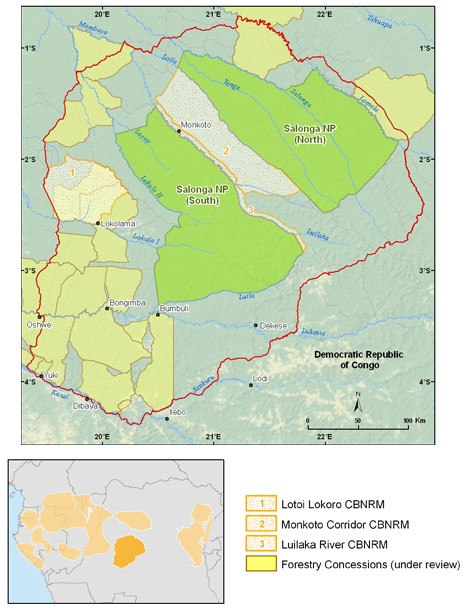
July 2014—Salonga National Park, located in the center of the Democratic Republic of Congo, is home to the endangered bonobo, one of the closest relatives to humans. This national park, in the heart of the Salonga landscape, is a World Heritage Site and home to significant populations of forest elephants, bongos, pangolins, Congo peacocks and hippopotami.
USAID partners with the World Wildlife Fund and the Zoological Society of Milwaukee to collect patrol data and wildlife surveys within the park.
"Our studies confirm that the Salonga Park is the world's largest protected expanse of bonobo habitat and that poaching is the greatest threat to wildlife in the park, including bonobos," said Gay Reinartz, director of the Bonobo and Congo Biodiversity Initiative.
During the course of regular park patrols in 2010, a sharp increase in hunting activity and disturbance of wildlife was detected. Elephant poachers had infiltrated the park and established themselves along the Yenge River. Under-trained and ill-equipped, park guards were unable to control poaching by the heavily armed and well-organized criminals looking to cash in on ivory worth over $1,000 per kilogram in some international markets.
Backed with this evidence of poaching and concerned about reports of illegal weapons, the Congolese Government quickly committed over 300 military personnel to root out the poachers through Operation Bonobo. In October 2011, in collaboration with Salonga National Park authorities, the Congolese military conducted a sweep of the park and surrounding communities to seize illegal weapons and arrest suspected poachers.
One year later, authorities had arrested a total of 30 suspected poachers, seven of whom have been sentenced to prison. In addition, more than 120 high-powered firearms were confiscated, including assault rifles. For the first time in two years, Zoological Society of Milwaukee research teams and park guards have been able to safely navigate and survey the Yenge River, where they have established a new control post.
Data collected six months before and six months after the start of Operation Bonobo show a dramatic contrast in animal distribution and poaching levels. Not only have signs of humans virtually disappeared from the park, elephant circulation has increased three-fold and become more widespread. The data demonstrates the importance of combining guard-based bio-monitoring, strong enforcement operations, and long-term commitment to park guards.
USAID's Central Africa Regional Program for the Environment program supports biodiversity conservation in eight major landscapes throughout the Congo Basin, including the Salonga landscape in central DRC. The program and a World Wildlife Fund-led Salonga consortium work together to reduce the rate of forest degradation and biodiversity loss in the 36,560 square mile landscape, an area the size of the state of Indiana. The program, which began in 1997, is slated to end in 2016.
LINKS







Comment
Make a general inquiry or suggest an improvement.